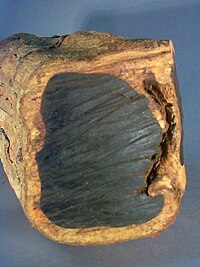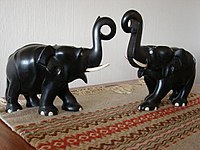Ebony is a dense black hardwood, most commonly yielded by several different species in the genus Diospyros. Ebony is dense enough to sink in water. It is finely-textured and has a very smooth finish when polished, making it valuable as an ornamental wood. The word ebony derives from the Ancient Egyptian hbny, via the Ancient Greek ἔβενος (ébenos), by way of Latin and Middle English.

Species
Species of ebony include Diospyros ebenum (Ceylon ebony), native to southern India and Sri Lanka; Diospyros crassiflora (Gabon ebony), native to western Africa; and Diospyros celebica (Makassar ebony), native to Indonesia and prized for its luxuriant, multi-colored wood grain. Mauritius ebony, Diospyros tesselaria, was largely exploited by the Dutch in the 17th century. Some species in the genus Diospyros yield an ebony with similar physical properties, but striped rather than evenly black (Diospyros ebenum).
Uses
Ebony has a long history of use, with carved pieces having been found in Ancient Egyptian tombs. By the end of the 16th century, fine cabinets for the luxury trade were made of ebony in Antwerp. The wood's dense hardness lent itself to refined moldings framing finely detailed pictorial panels with carving in very low relief (bas-relief), usually of allegorical subjects, or with scenes taken from classical or Christian history. Within a short time, such cabinets were also being made in Paris, where their makers became known as ébénistes, which remains the French term for a cabinetmaker.


Rough ebony
Species
Species of ebony include Diospyros ebenum (Ceylon ebony), native to southern India and Sri Lanka; Diospyros crassiflora (Gabon ebony), native to western Africa; and Diospyros celebica (Makassar ebony), native to Indonesia and prized for its luxuriant, multi-colored wood grain. Mauritius ebony, Diospyros tesselaria, was largely exploited by the Dutch in the 17th century. Some species in the genus Diospyros yield an ebony with similar physical properties, but striped rather than evenly black (Diospyros ebenum).
Uses
Ebony has a long history of use, with carved pieces having been found in Ancient Egyptian tombs. By the end of the 16th century, fine cabinets for the luxury trade were made of ebony in Antwerp. The wood's dense hardness lent itself to refined moldings framing finely detailed pictorial panels with carving in very low relief (bas-relief), usually of allegorical subjects, or with scenes taken from classical or Christian history. Within a short time, such cabinets were also being made in Paris, where their makers became known as ébénistes, which remains the French term for a cabinetmaker.

Ebony label depicting the pharaoh Den, found in his tomb in Abydos, circa 3000 BC
Modern uses are largely restricted to small items, such as crucifixes and musical instrument parts, including black piano and harpsichord keys, violin, viola, mandolin, guitar, double bass, and cello fingerboards, tailpieces, pegs, chinrests and bow frogs. Many plectra, or guitar picks, are made from this black wood. Traditionally, the black pieces in chess sets were made from ebony, with rare boxwood or ivory being used for the white pieces. Modern East Midlands-style lace-making bobbins, also being small, are often made of ebony and look particularly decorative when bound with brass or silver wire. Due to its strength, many handgun grips and rifle fore-end tips are made of ebony, as are the butts of pool cues.
As a result of unsustainable harvesting, many species yielding ebony are now considered threatened. Africa in particular has had most of its indigenous ebony cut down illegally, and for this reason it has become common for street traders to blacken lighter woods with shoe polish in an effort to make a sale.

Legal Penalties for Illegal Sales and Importation
Elephant carvings from Sri Lanka, made from ebony, in this case likely Gabon ebony (Diospyros crassiflora
In some countries like Sri Lanka, ebony is a protected species and selling of ebony logs is illegal (most often punishable by imprisonment), due to the wood's rarity and high price.
In 2012, the Gibson Guitar company was raided by the US Fish and Wildlife Service for violations of the Lacey Act of 1900, which prohibits the importation of threatened woods and other materials. Gibson had been buying illegally harvested hardwoods—such as the Madagascar ebony—from protected forests, and using the wood for their guitar fretboards.
Pete Lowry, ebony and rosewood expert at the Missouri Botanical Garden, calls the Madagascar wood trade the "equivalent of Africa's blood diamonds".
References- ^ "http://www.treehugger.com/corporate-responsibility/gibson-guitar-company-admits-using-illegal-rainforest-woods-settles-government.html".
External Links
- Red List —For recommendations found under the IUCN.
- Wikipedia





No comments:
Post a Comment